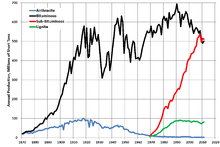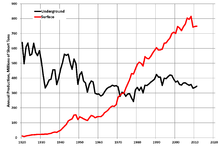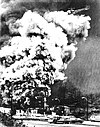
Anthracite, also known as hard coal and black coal, is a hard, compact variety of coal that has a submetallic lustre. It has the highest carbon content, the fewest impurities, and the highest energy density of all types of coal and is the highest ranking of coals.

The United Mine Workers of America is a North American labor union best known for representing coal miners. Today, the Union also represents health care workers, truck drivers, manufacturing workers and public employees in the United States and Canada. Although its main focus has always been on workers and their rights, the UMW of today also advocates for better roads, schools, and universal health care. By 2014, coal mining had largely shifted to open pit mines in Wyoming, and there were only 60,000 active coal miners. The UMW was left with 35,000 members, of whom 20,000 were coal miners, chiefly in underground mines in Kentucky and West Virginia. However it was responsible for pensions and medical benefits for 40,000 retired miners, and for 50,000 spouses and dependents.

The Coal Region is a region of Northeastern Pennsylvania. It is known for being home to the largest known deposits of anthracite coal in the world with an estimated reserve of seven billion short tons.
The history of coal mining goes back thousands of years, with early mines documented in ancient China, the Roman Empire and other early historical economies. It became important in the Industrial Revolution of the 19th and 20th centuries, when it was primarily used to power steam engines, heat buildings and generate electricity. Coal mining continues as an important economic activity today, but has begun to decline due to the strong contribution coal plays in global warming and environmental issues, which result in decreasing demand and in some geographies, peak coal.

The Coal strike of 1902 was a strike by the United Mine Workers of America in the anthracite coalfields of eastern Pennsylvania. Miners struck for higher wages, shorter workdays, and the recognition of their union. The strike threatened to shut down the winter fuel supply to major American cities. At that time, residences were typically heated with anthracite or "hard" coal, which produces higher heat value and less smoke than "soft" or bituminous coal.

The Lattimer massacre was the violent deaths of at least 19 unarmed striking immigrant anthracite miners at the Lattimer mine near Hazleton, Pennsylvania, United States, on September 10, 1897. The miners, mostly of Polish, Slovak, Lithuanian and German ethnicity, were shot and killed by a Luzerne County sheriff's posse. Scores more workers were wounded. The massacre was a turning point in the history of the United Mine Workers (UMW).
The Logan Coalfield is a coalfield located in Logan County and Wyoming County of southern West Virginia, in the Appalachia region of the eastern United States.
Coal mining regions are significant resource extraction industries in many parts of the world. They provide a large amount of the fossil fuel energy in the world economy.
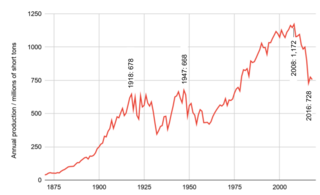
Coal mining is an industry in transition in the United States. Production in 2019 was down 40% from the peak production of 1,171.8 million short tons in 2008. Employment of 43,000 coal miners is down from a peak of 883,000 in 1923. Generation of electricity is the largest user of coal, being used to produce 50% of electric power in 2005 and 27% in 2018. The U.S. is a net exporter of coal. U.S. coal exports, for which Europe is the largest customer, peaked in 2012. In 2015, the U.S. exported 7.0 percent of mined coal.

The Coal Wars were a series of armed labor conflicts in the United States, roughly between 1890 and 1930. Although they occurred mainly in the East, particularly in Appalachia, there was a significant amount of violence in Colorado after the turn of the century.
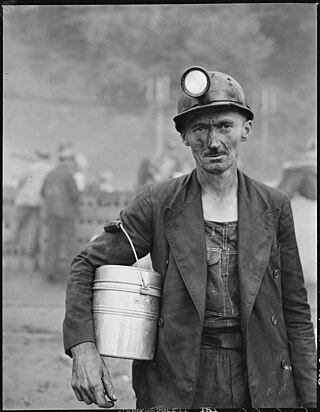
People have worked as coal miners for centuries, but they became increasingly important during the Industrial revolution when coal was burnt on a large scale to fuel stationary and locomotive engines and heat buildings. Owing to coal's strategic role as a primary fuel, coal miners have figured strongly in labor and political movements since that time.
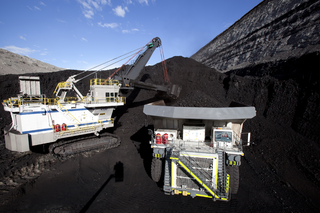
Coal mining in Wyoming has long been a significant part of the state's economy. Wyoming has been the largest producer of coal in the United States since 1986, and in 2018, coal mines employed approximately 1% of the state’s population. In 2013, there were 17 active coal mines in Wyoming, which produced 388 million short tons, 39 percent of all the coal mined in the US, and more than three times the production of second-place West Virginia. Market forces, including the low price of natural gas from the fracking boom—coal's main competition—contributed to the steep drop in coal production in the 2000s as electricity generation switched from coal to gas.
The 1927 Indiana bituminous strike was a strike by members of the United Mine Workers of America (UMWA) against local bituminous coal companies. Although the struggle raged throughout most of the nation's coal fields, its most serious impact was in western Pennsylvania, including Indiana County. The strike began on April 1, 1927, when almost 200,000 coal miners struck the coal mining companies operating in the Central Competitive Field, after the two sides could not reach an agreement on pay rates. The UMWA was attempting to retain pay raises gained in the contracts it had negotiated in 1922 and 1924, while management, stating that it was under economic pressure from competition with the West Virginia coal mines, was seeking wage reductions. The strike proved to be a disaster for the union, as by 1929, there were only 84,000 paying members of the union, down from 400,000 which belonged to the union in 1920.
Scotts Run is a geographical division of the Cass District in Monongalia County, West Virginia, United States. Currently, it encompasses thirteen small, unincorporated communities. Located a few miles from Morgantown, this area's predominant industry in the early twentieth century was coal mining and production. Scotts Run became well known nationally during the years of the Great Depression, when photographers and the relief efforts of First Lady Eleanor Roosevelt publicized the impoverished conditions faced by the community. Since the decline in the coal industry in the area, Scotts Run's population has rapidly decreased. However, the current community is active in revitalization efforts to promote new businesses and heritage tourism.

There are two types of coal found in Pennsylvania: anthracite and bituminous. Anthracite coal is a natural mineral with a high carbon and energy content that gives off light and heat when burned, making it useful as a fuel. It was possibly first used in Pennsylvania as a fuel in 1769, but its real history begins with a documented discovery near Summit Hill and the founding of the Lehigh Coal Mine Company in 1792 to sporadically send expeditions to the wilderness atop Pisgah Ridge to mine the deposits, mostly with notable lack of great success, over the next 22 years. The owners of this company were absentee management—reliant on teams of workers sent under a foreman to fell timber to build so called 'arks', then mine coal around nine miles from the right bank Lehigh, then trek with mule loads to fill the boats for the trip down the rapid-strewn Lehigh River, and then more than 60 miles (97 km) to the Lehigh Valley docks on the unimproved, often log-choked river.

The Coal miners' strike of 1873, was a strike against wage cuts in the Mahoning, Shenango, and TuscarawasValleys of northeastern Ohio and northwestern Pennsylvania. In the Tuscarawas Valley, the labor action lasted six months, and in the Mahoning Valley four and a half months, but the walkouts failed. The introduction of imported strikebreakers and manufacturers finding substitutes for the area's special block-coal, forced the organized miners back to work at prevailing wages.
The Federal Coal Commission was an agency of the Federal government of the United States of America, enacted by the U.S. Congress in September 1922 and headed by former U.S. Vice President Thomas R. Marshall.
Bituminous Coal Operators Association (BCOA) is a coal mining lobbying organization. It was founded in 1950 by various companies to deal with the UMWA and unionizing of mines during the change from human labor to mechanical labor. The BCOA would strike deals between miners, mine companies, and coal buying companies to provide a steady flow of continuous labor and a steady purchasing price for coal. The main deals normally contained negotiations of some miners being put out of work by mechanizations while the miners left would be guaranteed a steady job and pay as long as they agreed to not hold up progress with strikes and other activities. In addition, the BCOA hears requests from the UMWA employees for pay raises but often results in unprotected employees being laid off after a deal has been reached. The current president of BCOA is David M Young. He is the main representative for the BCOA and lobbyist.

The 1922 UMW Miner strike or The Big Coal Strike was a nationwide general strike of miners in the US & Canada after the United Mine Worker's (UMW) trade union contract expired on March 31, 1922. The strike decision was ordered March 22 to start effective April 1. Around 610,000 mine workers struck. About 100,000 of the striking miners were non-union or not associated with the UMW.


